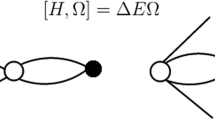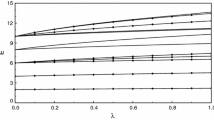Abstract
In this chapter, we discuss a more specific model for the transition between the vibrational manifolds using parallel displaced harmonic normal modes, for which the time-correlation function can be evaluated explicitly. We consider the limit of high frequency modes (or low temperature) where vibrational progressions appear and the limit of low frequencies (or high temperature) where the lineshape becomes Gaussian where position and width only depend on the total reorganization energy.
Access provided by CONRICYT-eBooks. Download chapter PDF
Similar content being viewed by others
In this chapter, we discuss a more specific model for the transition between the vibrational manifolds using parallel displaced harmonic normal modes, for which the time-correlation function can be evaluated explicitly. We consider the limit of high frequency modes (or low temperature) where vibrational progressions appear and the limit of low frequencies (or high temperature) where the lineshape becomes Gaussian where position and width only depend on the total reorganization energy.
1 The Time-Correlation Function in the Displaced Harmonic Oscillator Approximation
We apply the harmonic approximation (17.11) for the nuclear motion to the zero-order Hamiltonian (18.31)
Displaced oscillator model. The displaced oscillator model assumes that the normal mode eigenvectors are the same in both electronic states involved. Then the different modes are still independent. The figure shows the potential energy along one such normal mode Q. The minima at \(Q_{g}^{0}\) and \(Q_{e}^{0}\) are shifted relative to each other by a distance \(d=Q_{e}^{0}-Q_{g}^{0}\). The elongation of the normal mode is denoted as \(q_{g(e)}=Q-Q_{g(e)}^{0}\). The curvature of the two parabolas is the same. Thus neglecting frequency changes in the excited state, the vibrationless transition energy \(\hbar \omega _{00}\) equals the pure electronic transition energy \(E_{e}^{min}-E_{g}^{min}\). The reorganization energy \(E_{R}=\frac{1}{2}\omega ^{2}d^{2}\) is the amount of energy which can be released in the excited state after a vertical transition from the vibronic groundstate
In a simplified but popular model, we neglect mixing of the normal modes (parallel mode approximation, the eigenvectors (\(u_{j}^{r}\) in 17.13) are the same) and frequency changes ( \(\omega _{r}^{g}=\omega _{r}^{e}=\omega _{r}\)) in the excited state but allow for a shift of the equilibrium position \((q_{r}^{e}=q_{r}^{g}+d_{r}\)).Footnote 1 The potential energy for the two states then is approximated by (Fig. 19.1)
The vertical excitation energy isFootnote 2
with the reorganization energy
We introduce the ladder operators by substituting
Since \(d_{r}\) is real valued we find
with the vibronic coupling parameter
From
we obtain the “displaced harmonic oscillator” model (DHO)
where the superscript g is omitted from now and the last term is the reorganization energy
The correlation function (18.50)
with
factorizes in the parallel mode approximation
As shown in the appendix this can be evaluated as
with the average phonon numbers
Expression (19.14) contains phonon absorption (positive frequencies) and emission processes (negative frequencies). We discuss two important limiting cases.
2 High Frequency Modes
In the limit \(\hbar \omega _{r}\gg k_{B} T\) the average phonon number
is small and the correlation function becomes
Expansion of \(F_{r}(t)\) as a power series of \(g_{r}^{2}\) gives
which corresponds to a progression of transitions \(0\rightarrow j\,\omega _{r}\) with Franck–Condon factors (Fig. 19.2)
Progression of a low frequency mode. The Fourier transform of (19.15) is shown for typical values of \(\hbar \omega =50\,\mathrm{cm}^{-1}\), 1, \(E_{r}=50\,\mathrm{cm}^{-1}\) and (a) \(kT=10\, \mathrm{cm}^{-1}\) (b) \(kT=200\,\mathrm{cm}\,^{-1}\). A small damping was introduced to obtain finite linewidths
3 Low Frequency Modes
In the high temperature limit (\(\hbar \omega _{r}\ll k_{B}T\)) the time-correlation function of one oscillator (19.15) has peaks at \(t=0,\pm \frac{2\pi }{\omega _{r}},\dots \) which become very sharp for large \(\overline{n}_{r}\approx k_{B}T/\hbar \omega _{r}\) Footnote 3 (Fig. 19.3). The product correlation function of many oscillators is non vanishing only around \(t=0\), i.e. the correlation function decays rapidly and can be approximated by the Taylor series (in this context also known as short time approximation)
The lineshape is approximately given by a Gaussian (Fig. 19.4)
with the reorganization energy
and the variance
Notes
- 1.
We retain only the lowest order of the potential difference.
- 2.
Without frequency changes the zero point energies are the same and \(E_{e}^{min}-E_{g}^{min}=E_{e}^{0}-E_{g}^{0}=\hbar \omega _{00}\).
- 3.
Also for very strong vibronic coupling \(g_{r}\).
Author information
Authors and Affiliations
Corresponding author
Rights and permissions
Copyright information
© 2017 Springer-Verlag GmbH Germany
About this chapter
Cite this chapter
Scherer, P.O.J., Fischer, S.F. (2017). The Displaced Harmonic Oscillator. In: Theoretical Molecular Biophysics. Biological and Medical Physics, Biomedical Engineering. Springer, Berlin, Heidelberg. https://doi.org/10.1007/978-3-662-55671-9_19
Download citation
DOI: https://doi.org/10.1007/978-3-662-55671-9_19
Published:
Publisher Name: Springer, Berlin, Heidelberg
Print ISBN: 978-3-662-55670-2
Online ISBN: 978-3-662-55671-9
eBook Packages: Physics and AstronomyPhysics and Astronomy (R0)








